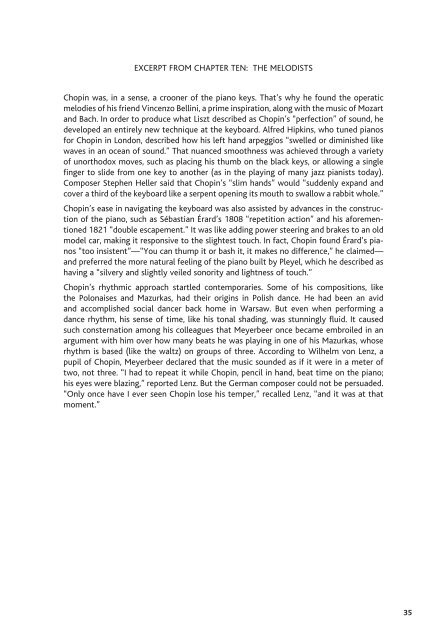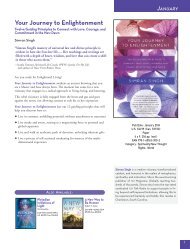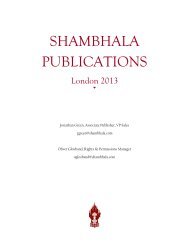You also want an ePaper? Increase the reach of your titles
YUMPU automatically turns print PDFs into web optimized ePapers that Google loves.
EXCERPT FROM CHAPTER TEN: THE MELODISTS<br />
Chopin was, in a sense, a crooner of the piano keys. That’s why he found the operatic<br />
melodies of his friend Vincenzo Bellini, a prime inspiration, along with the music of Mozart<br />
and Bach. In order to produce what Liszt described as Chopin’s “perfection” of sound, he<br />
developed an entirely new technique at the keyboard. Alfred Hipkins, who tuned pianos<br />
for Chopin in London, described how his left hand arpeggios “swelled or diminished like<br />
waves in an ocean of sound.” That nuanced smoothness was achieved through a variety<br />
of unorthodox moves, such as placing his thumb on the black keys, or allowing a single<br />
finger to slide from one key to another (as in the playing of many jazz pianists today).<br />
Composer Stephen Heller said that Chopin’s “slim hands” would “suddenly expand and<br />
cover a third of the keyboard like a serpent opening its mouth to swallow a rabbit whole.”<br />
Chopin’s ease in navigating the keyboard was also assisted by advances in the construction<br />
of the piano, such as Sébastian Érard’s 1808 “repetition action” and his aforementioned<br />
1821 “double escapement.” It was like adding power steering and brakes to an old<br />
model car, making it responsive to the slightest touch. In fact, Chopin found Érard’s pianos<br />
“too insistent”—“You can thump it or bash it, it makes no difference,” he claimed—<br />
and preferred the more natural feeling of the piano built by Pleyel, which he described as<br />
having a “silvery and slightly veiled sonority and lightness of touch.”<br />
Chopin’s rhythmic approach startled contemporaries. Some of his compositions, like<br />
the Polonaises and Mazurkas, had their origins in Polish dance. He had been an avid<br />
and accomplished social dancer back home in Warsaw. But even when performing a<br />
dance rhythm, his sense of time, like his tonal shading, was stunningly fluid. It caused<br />
such consternation among his colleagues that Meyerbeer once became embroiled in an<br />
argument with him over how many beats he was playing in one of his Mazurkas, whose<br />
rhythm is based (like the waltz) on groups of three. According to Wilhelm von Lenz, a<br />
pupil of Chopin, Meyerbeer declared that the music sounded as if it were in a meter of<br />
two, not three. “I had to repeat it while Chopin, pencil in hand, beat time on the piano;<br />
his eyes were blazing,” reported Lenz. But the German composer could not be persuaded.<br />
“Only once have I ever seen Chopin lose his temper,” recalled Lenz, “and it was at that<br />
moment.”<br />
35






